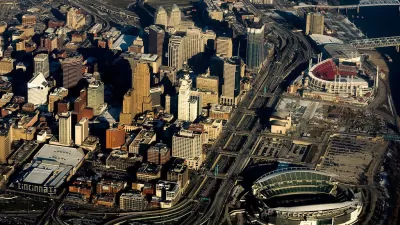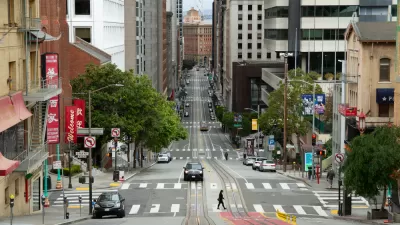Central districts benefit from diversity, but a century of disinvestment and exodus has put many in a precarious position.

The downtown business districts of many American cities, write Emily Badger and Quoctrung Bui in the New York Times, "were created through subtraction." The office buildings we think of as the core of these districts were all that remained after residents, department stores, small retailers, and entertainment venues fled the central city. This "precarious urban monoculture" "was already susceptible to shocks and recessions before the pandemic."
Now, with offices emptier than ever and many remote workers unwilling to return, the future of the central business district has become an urgent question. "Downtowns, like investment portfolios, are more sustainable when they’re diverse. The past year has made that plainly clear in places like Midtown Manhattan, where property tax assessments, transit ridership and small-business revenue fell particularly far during the pandemic."
Yet despite efforts to rebrand urban downtowns as complete neighborhoods suitable for living, working, and playing in, "a century of history" has left many of them hollowed out and dependent on office buildings for their tax base. Cities that have diversified, like Austin, faced less severe economic losses during the pandemic. "The lesson that downtowns need more than offices is 'not just true in this post-Covid world,' said Kourtny Garrett, the head of Downtown Dallas, Inc. 'For us in Dallas, that’s been true since the big crash in the ’80s.'"
FULL STORY: The Downtown Office District Was Vulnerable. Even Before Covid.

Planetizen Federal Action Tracker
A weekly monitor of how Trump’s orders and actions are impacting planners and planning in America.

DARTSpace Platform Streamlines Dallas TOD Application Process
The Dallas transit agency hopes a shorter permitting timeline will boost transit-oriented development around rail stations.

Four Reasons Urban Planners Can’t Ignore AI
It’s no longer a question of whether AI will shape planning, but how. That how is up to us.

Bikeshare for the Win: Team Pedals to London Cricket Match, Beats Rivals Stuck in Traffic
While their opponents sat in gridlock, England's national cricket team hopped Lime bikes, riding to a 3-0 victory.

Amtrak’s Borealis Exceeds First Year Ridership Expectations
205,800 passengers have boarded the St. Paul to Chicago line, well above initial MDOT projections.

Study: 4% of Truckers Lack a Valid Commercial License
Over 56% of inspected trucks had other violations.
Urban Design for Planners 1: Software Tools
This six-course series explores essential urban design concepts using open source software and equips planners with the tools they need to participate fully in the urban design process.
Planning for Universal Design
Learn the tools for implementing Universal Design in planning regulations.
City of Mt Shasta
City of Camden Redevelopment Agency
City of Astoria
Transportation Research & Education Center (TREC) at Portland State University
US High Speed Rail Association
City of Camden Redevelopment Agency
Municipality of Princeton (NJ)




























